|
|
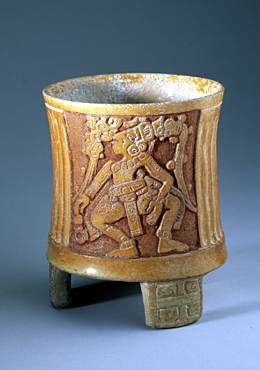
|
Various supernatural beings, who were critical to the definition of divine kingship, presided over the Maya world and its inhabitants. Kings acted in concert with gods and other spiritual beings, who bestowed supernatural faculties on Maya rulers. This carved tripod vessel portrays a king in the guise of the Maize God, who is dancing, a primary form of ritual expression among the Maya.
Fluted Tripod Vessel. |
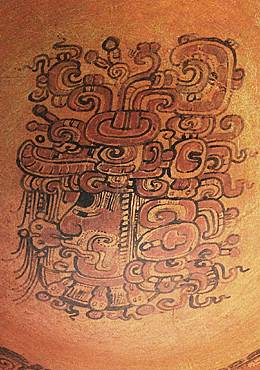
|
Commissioned by the Naranjo king K'inich Tajal Chaak in the early sixth century AD, this painted plate portrays a version of the Maize god from an earlier era. The face is framed by a series of beads, and the mouth is the elongated version of the early Maize God forms.
Plate With Maize God. |
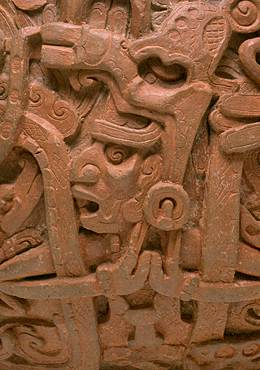
|
This detail of a carved bowl depicts the sun god, K'inich Ajaw. The vessel apparently replicates in ceramic the tradition of gourd and wood carving, of which few examples survive. The central figure in the guise of the Sun God commemorates a trance state or ritual performance, signaled by the two Vision Serpents held in his arms.
Carved Bowl Depicting K'inich Ajaw. |
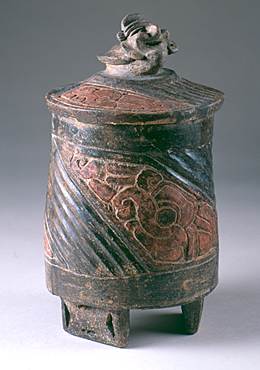
|
An aged deity variously known as God N, Mam, or Pawahtun is often shown emerging from conch shells or turtle carapaces, as here on this lidded vessel. Four Pawahtuns serve as the pillars that support the world, and the Maya perceive the surface of the world as the back of a turtle.
Lidded Vessel Depicting Mam and Turtle Shell. |
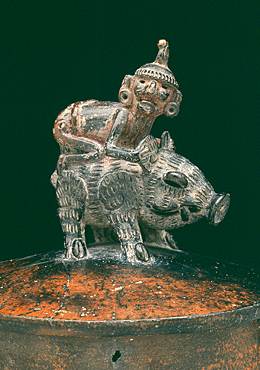
|
Itzamnaaj, another aged deity, is one of the most important in the pantheon of the ancient Maya. In his headband he wears a flower marked with the ak'ab' (darkness) glyph. As a central deity in the acts of creation, he is associated with the sky. Here he rides on the back of a peccary, manifested in the night sky as the constellation Gemini.
Lidded Vessel Depicting Itzamnaaj on Back of Peccary. |
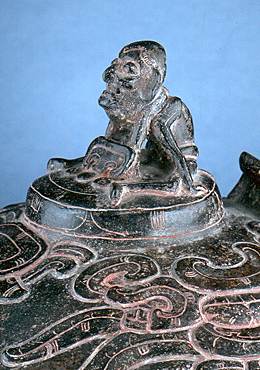
|
On the lid of this vessel, the aged figure sits on a disk representing the k'in/flower symbol. He is borne on the back of the supernatural avian known as the Principal Bird Deity, which wears the flower headband of Itzamnaaj.
Carved Blackware Vessel Depicting Itzamnaaj and Principal Bird Deity. |
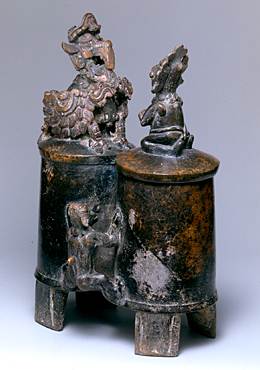
|
The Principal Bird Deity head as seen on this double-chambered censer stand resembles those found on Late Preclassic temple facades. This censer stand once sat on a bowl or brazier containing hot coals, which heated the surface of the vessel. The dish on top of the PBD's head supported an openwork incense burner, which contained copal. The warmed copal released the aroma and clouds of smoke that are important components of Maya ritual.
Double-Chambered Vessel Depicting Principal Bird Deity and Hero Twin. |
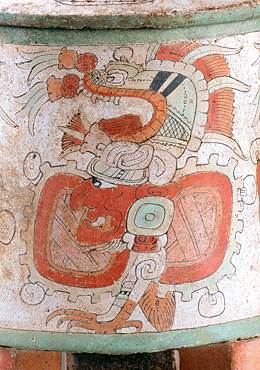
|
On the body of this lidded vessel (detail) are four manifestations of Itzamnaaj in his bird form with clawed feet, tail, and wings. The cylinder tripod vessel form is associated with Teotihuacan, but the taller and more slender shape and the human head effigy knob are typically Maya.
Lidded Tripod Vessel |
top home |
Copyright 2005 Los Angeles County Museum of Art